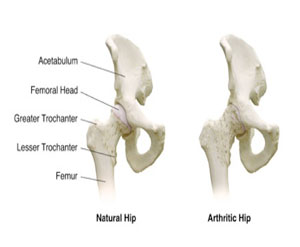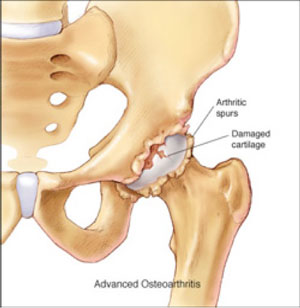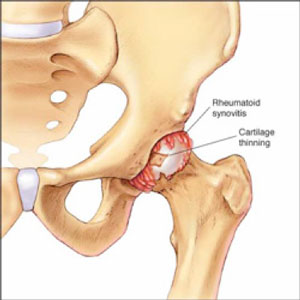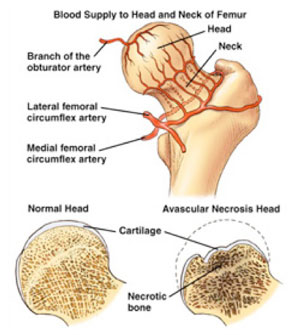To be seventy years young is sometimes far more cheerful and hopeful than to be forty years old
Oliver Wendall Holmes
Hip Conditions
Total Hip Replacement

The anatomy of the hip joint.
The hip joint creates the jointed connected between the trunk and the legs. It connects the pelvis and the thigh bones. It is a ball-and-socket joint which, due to its shape, enables greater freedom of movement.
The ball portion of the joint is called the femoral head, and is part of the upper leg bone (femur). The socket portion is called the acetabulum, and is part of the pelvic bone. The femoral head (ball) fits into the acetabulum (socket) and moves within its natural fluid, called synovial fluid, which helps to lubricate the joint during motion.
The synovial fluid also serves as a sort of shock absorber which intercepts the powerful forces that impinge on the joint during a person’s lifetime. The bones are connected by ligaments, which impart the necessary stability to the joint. The joint is moved by muscles and tendons.

Disease of the Hip
There are a number of causes that can lead to disease of the hip joint. The most common one is pathology wear of the joint cartilage – osteoarthritis affecting usually middle-aged and older people.
This is a non-inflammatory degenerative joint disease characterized by the breakdown of the joint’s cartilage. Cartilage that cushions the bones of the hip starts to erode, eventually allowing the bones to grind or rub together and causing hip pain and stiffness. The exact cause of osteoarthritis is unknown.
Secondary osteoarthritis, which appears as a sequel to a known underlying disease (for example rheumatism, circulatory disorders of metabolic origin).
Congenital or predisposition-conditioned deformities of the hip joint and accidents (traumatic arthritis) are further causes, which lead to injury to bones or joint parts.

A condition called avascular necrosis can result from a serious hip injury or fracture. In avascular necrosis, the blood supply to the ball portion (the femoral head) of the thighbone is cut off and the bone begins to wither. As a result, the surrounding cartilage begins to deteriorate, producing pain and other symptoms.
What is total hip replacement (THR)?
In principle, total hip replacement or THR is the replacement of the diseased joint by an artificial implant. The replacement of an injured joint is one of this century’s major orthopaedic advances.
Many decades ago, the relatively simple structure of the hip joint- a ball-and-socket joint - had inspired physicians and medical technicians to create an artificial copy, and in the course of time follow up examinations and improvements in operative methods.

The hip prosthesis is designed to simulate the human anatomy and is comprised of a hip socket and a hip shaft. The ball head, which articulates in the socket, is placed on the hip shaft.
The joint components, ie, the joint surfaces in direct contact with each other, comprise a ceramic or metal head running against a polyethylene socket. The socket can also be made entirely of metal or ceramic. Materials used in the joint are alloys and ceramics that have been specially developed for medical purposes. They present good tissue tolerance and allow the function to be painless and lasting as possible.
When do you need a hip replacement?

Total hip replacement is an operation that has been performed successfully for approximately 25 years and with modern day research and technology, the results continue to improve.
All the mobile joints of the body, such as the hip, knee and shoulder, consist of two layers of articular cartilage, separated by a very thin layer of fluid.
When all operation-free treatments (physiotherapy, analgesic or anti-inflammatory drugs) have been exhausted, implantation of an artificial hip joint – also called total hip replacement (THR) – will usually offer freedom from pain and a restoration of mobility.
What are artificial hip joints made of?
Materials used for artificial joints are highly developed. They provide maximum tolerance and long term acceptance by the human body, which is called biocompatibility.
Metals play a vital role in manufacturing artificial joints. Implants are subjected to very high loads inside the body. As a consequence, they must feature advanced material strength in order to take all the load cycles during the many years of use. Stems for hips or tibial components for knee prostheses are hot forged in order to gain the required strength resistance of the material. In the earlier days all metals were casted whereas today hot forging has become a standard process providing improved metallurgical and physical results.
How is the implant affixed in the body?
There are two main types of fixation philosophies-cemented and porous. Both can be effective in the replacement of hip joints. Dr Morgan will discuss with you prior to surgery the best type of fixation that is specific to your needs.
The decision as to whether to use a cemented or press-fit component depends upon many factors, including the manufacturer’s intended use of the product, surgeon philosophy and the patient’s condition.

- (07) 3812 3855
- Suite 3, 10 Pring Street, Ipswich, QLD 4305
-
Monday - Thursday 8:30am to 5:00pm
Friday 8:30am to 3:00pm
